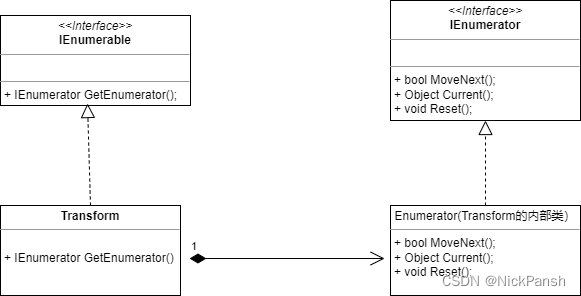迭代器模式

迭代器模式:提供一种方法顺序访问一个聚合对象中的各个元素,且不暴露该对象的内部表示。
Unity3D中的迭代器
迭代器模式在Unity游戏开发中用的非常非常多!
.NET框架提供了IEnumerable和IEnumerator接口(写法比GOF的原始版迭代器模式更简洁)
划重点:一个collection要支持Foreach进行遍历,就必须实现IEnumerable,并以某种方式返回迭代器对象:IEnumerator。
Array/ArrayList与迭代器
平常用的最多的Array,ArrayList等就使用了迭代器模式。
- 声明IEnumerable接口(Array—IList—ICollection—IEnumerable)
- 实现IEnumerator
public abstract class Array : ICloneable, IList, IStructuralComparable, IStructuralEquatable
// GetEnumerator returns an IEnumerator over this Array.
//
// Currently, only one dimensional arrays are supported.
//
public IEnumerator GetEnumerator()
{
int lowerBound = GetLowerBound(0);
if (Rank == 1 && lowerBound == 0)
return new SZArrayEnumerator(this);
else
return new ArrayEnumerator(this, lowerBound, Length);
}
}
Tips:
对于IEnumerable和IEnumerator,FCL提供了泛型和非泛型两大类型。因为非泛型装箱两大问题:和拆箱带来的性能开销问题,所以和泛型集合相比,已经变得越来越鸡肋。两大问题:
-
缺乏类型安全性。它返回object类型的引用,然后必须转化为实际类型
-
不希望的装箱操作。
[外链图片转存失败,源站可能有防盗链机制,建议将图片保存下来直接上传(img-wNiH505B-1676346423178)(null)]
Transform与迭代器
Unity的Transform也使用了迭代器模式。
public partial class Transform : Component, IEnumerable
{
//*undocumented* Documented separately
public IEnumerator GetEnumerator()
{
return new Transform.Enumerator(this);
}
//Comment by NickPansh:这里Unity用内部类的方式实现IEnumerator,这也是一个聚合关系的常规做法。
private class Enumerator : IEnumerator
{
Transform outer;
int currentIndex = -1;
internal Enumerator(Transform outer)
{
this.outer = outer;
}
//*undocumented*
public object Current
{
get { return outer.GetChild(currentIndex); }
}
//*undocumented*
public bool MoveNext()
{
int childCount = outer.childCount;
return ++currentIndex < childCount;
}
//*undocumented*
public void Reset() { currentIndex = -1; }
}
}
协程(Coroutine)与迭代器
Unity的协程也用了迭代器模式。
MonoBehaviour.cs
public class MonoBehaviour : Behaviour{
// Starts a coroutine.
public Coroutine StartCoroutine(IEnumerator routine)
{
if (routine == null)
throw new NullReferenceException("routine is null");
if (!IsObjectMonoBehaviour(this))
throw new ArgumentException("Coroutines can only be stopped on a MonoBehaviour");
return StartCoroutineManaged2(routine);
}
// Stop a coroutine.
public void StopCoroutine(IEnumerator routine)
{
if (routine == null)
throw new NullReferenceException("routine is null");
if (!IsObjectMonoBehaviour(this))
throw new ArgumentException("Coroutines can only be stopped on a MonoBehaviour");
StopCoroutineFromEnumeratorManaged(routine);
}
extern Coroutine StartCoroutineManaged2(IEnumerator enumerator);
extern Coroutine StartCoroutineManaged(string methodName, object value);
}
Coroutines.cs
internal class SetupCoroutine
{
[RequiredByNativeCode]
[System.Security.SecuritySafeCritical]
unsafe static public void InvokeMoveNext(IEnumerator enumerator, IntPtr returnValueAddress)
{
if (returnValueAddress == IntPtr.Zero)
throw new ArgumentException("Return value address cannot be 0.", "returnValueAddress");
(*(bool*)returnValueAddress) = enumerator.MoveNext();
}
[RequiredByNativeCode]
static public object InvokeMember(object behaviour, string name, object variable)
{
// We need these stubs because methods marked with [RequiredByNativeCode] must match between scripting backends
object[] args = null;
if (variable != null)
{
args = new System.Object[1];
args[0] = variable;
}
return behaviour.GetType().InvokeMember(name, BindingFlags.InvokeMethod | BindingFlags.Instance | BindingFlags.NonPublic | BindingFlags.Public, null, behaviour, args, null, null, null);
}
static public object InvokeStatic(Type klass, string name, object variable)
{
object[] args = null;
if (variable != null)
{
args = new System.Object[1];
args[0] = variable;
}
return klass.InvokeMember(name, BindingFlags.InvokeMethod | BindingFlags.Static | BindingFlags.NonPublic | BindingFlags.Public, null, null, args, null, null, null);
}
}
由于只是C#端的部分代码,看不全,这里做个解释。
协程的实现分为两部分:
- 协程本体(仅仅是一个能够中间暂停的函数,Unity直接使用了.NET框架的IEnumerator,它可以使用
yield来暂停,使用MoveNext()来继续执行) - 协程调度(由MonoBehaviour的声明周期调用实现)
Tips:
- Unity原生协程使用普通版本的IEnumerator,但是有些项目(比如倩女幽魂)自己造的协程轮子可能会使用泛型版本的IEnumerator
- 函数调用的本质是压栈,协程的唤醒也一样,调用IEnumerator.MoveNext()时会把协程方法体压入当前的函数调用栈中执行,运行到yield return后再弹栈。Unity中的协程是无栈协程,它不会维护整个函数调用栈,仅仅是保存一个栈帧。
ref:Unity协程的原理与应用 - 知乎 (zhihu.com)
结构
这里我直接画.Net框架里的迭代器UML图,以Transform为例。

动手实现
实际开发中,很少自定义迭代器,一般使用.NET内置的迭代器。
所以就不演示自定义迭代器了。
演示一下用IEnumerator进行遍历。
var arrList = new ArrayList();
arrList.Add("a");
arrList.Add("b");
arrList.Add("c");
arrList.Add("d");
arrList.Add("e");
arrList.Add("f");
arrList.Add("g");
// foreach (var item in arrList)
// {
// Debug.Log(item);
// }
// 效果等同于foreach
IEnumerator i = (IEnumerator)arrList.GetEnumerator();
while (i.MoveNext())
{
Debug.Log(i.Current);
}
演示一下不依靠协程,依靠Enumerator代码块实现方法迭代。
// 演示不依靠协程,也可以使用IEnumerator代码块创建可枚举方法
IEnumerator<int> SumAdd()
{
int sum = 0;
while (true)
{
yield return sum++;
}
}
void Update()
{
if (Input.anyKeyDown)
{
_enumerator.MoveNext();
Debug.Log(_enumerator.Current);
}
}
源码
完整代码已上传至nickpansh/Unity-Design-Pattern | GitHub